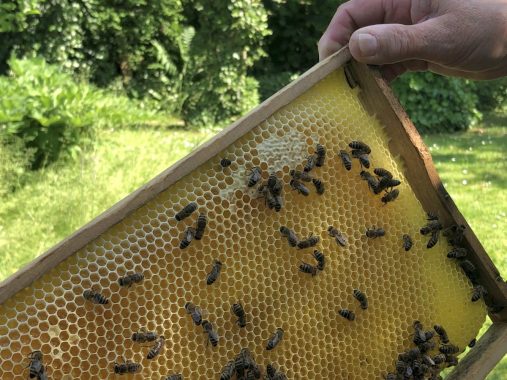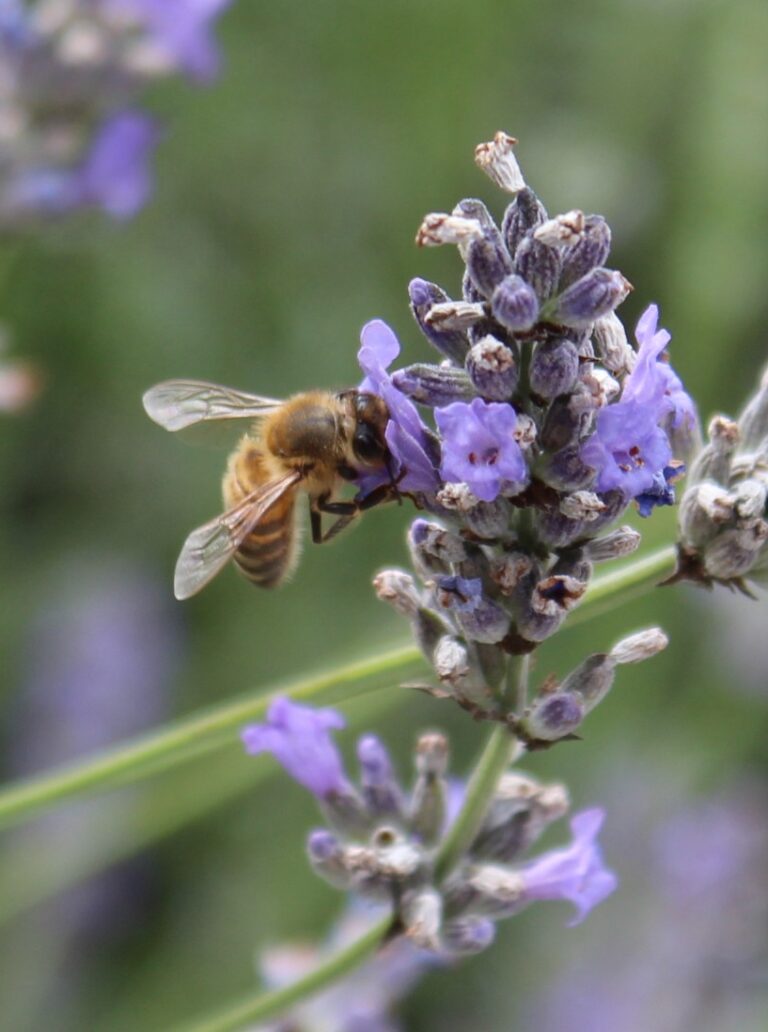
Bee dance, pollen panties, honey & hexagonal honeycomb construction
The little wonders in the world of honeybees
Did you know ...?
_ that honey bees communicate with each other through their dance? Various movements signal to the other bees in the hive the distance and direction in which new food has been found.
_ that honey bees are the third most important farm animal after cattle and pigs.
_ that bees can regulate the temperature in the hive. On hot summer days, they cool the temperature down to 35 degrees so that the eggs can ripen perfectly.
_ that a queen bee can live up to 5 years, but the normal honey bee only lives a maximum of 60 days during the busy summer season. The winter bee lives about 6 months.
What do bees do in winter?
During the winter, the bees warm each other in the hive and also protect their queen in their midst. When the temperature rises above 10 degrees, the bees become active again and make their first cleaning flight. The willow catkins and the hazelnut then provide the first important protein-rich pollen in spring. In May, at the time of the fruit blossom, the bee colony has grown to such an extent that they take over the fertilization with maximum performance so that seeds and fruits can develop.
How do the bees build their new home?
The bee houses, known as hives, are similar to a natural dwelling such as a hollow tree trunk. They provide protection from cold, rain, wind and heat, and the individual honeycomb boards can be inspected by the beekeeper at any time. The bees produce the fine wax to build the honeycombs. A construction cluster of bees sweats out the wax, which is then built into whole honeycombs as 6-cornered cells. A miracle of nature, which brings an optimal use of space and is very stable. Each cell and comb becomes a vessel for the honey and pollen. When the first cells are ready, the queen already begins to lay eggs and the flight bees create food.
What happens in the bee hive?
The hive is occupied by up to tens of thousands of female worker bees, which have a variety of tasks during their 50 -60 days of life. First, they clean the cells and keep the hive clean. As nurse bees, they feed the young brood. They also sweat out the fine little wax plates from which they build elaborate new combs. After 3 weeks, they take over guarding the flight hole. As flight bees, they eventually bring in water, pollen, nectar and propolis, and defend the hive if necessary.
In the summer months, several hundred drones (male bees) populate the hive. Their only job is to mate with a young queen outside the hive. Mated, this queen can then lay up to two thousand eggs a day. Before pressing an egg into the cell, she checks that the cell has been cleaned clean by the young bees. This enormous feat is only possible because she is surrounded by a court of bees that nurture her and provide her with the royal food juice - royal jelly. A queen can live up to 5 years.
After 21 days, the egg, via the larva and pupa, has grown into the finished young bee, which gnaws off the cell cover and thus hungrily sticks out its tongue so that the nurse bees can feed it. Thus strengthened, they soon take over the task of cleaning the cells. Later they switch to other tasks.
How is a new swarm formed?
In the period of natural 'reproduction' of a hive, some larvae are fed with the 'royal food juice' in the months of April until the summer solstice in June. New queens develop with this unique ‘food’ support. Already at the beginning of the pupal period of this royal offspring, the old queen moves out of the hive with some of the bees. The sound of thousands of bees is absolutely unique. The swarm of bees first gathers as a cluster of bees in a place close to the old dwelling. Next some trace bees swarm out to find a new dwelling. During this time, the swarm should be quickly recaptured so that it does not completely run away. As a beekeeper it is important to recognize the intention of the swarm at an early stage, i.e., before it leaves, and to prevent it from 'wanting to swarm'. So as a beekeeper you always have to be 'mentally' one step ahead of the bees by observing them closely. This is also in their own interest, because until the old hive and the new hive (swarm) again bring in the full honey harvest for the beekeeper, several weeks pass. In addition, a swarm that is not captured flies into the unknown and its future usually ends in death without the beekeeping care work.
How is a new swarm formed?
In the period of natural 'reproduction' of a hive, some larvae are fed with the 'royal food juice' in the months of April until the summer solstice in June. New queens develop with this unique ‘food’ support. Already at the beginning of the pupal period of this royal offspring, the old queen moves out of the hive with some of the bees. The sound of thousands of bees is absolutely unique. The swarm of bees first gathers as a cluster of bees in a place close to the old dwelling. Next some trace bees swarm out to find a new dwelling.
During this time, the swarm should be quickly recaptured so that it does not completely run away. As a beekeeper it is important to recognize the intention of the swarm at an early stage, i.e., before it leaves, and to prevent it from 'wanting to swarm'. So as a beekeeper you always have to be 'mentally' one step ahead of the bees by observing them closely. This is also in their own interest, because until the old hive and the new hive (swarm) again bring in the full honey harvest for the beekeeper, several weeks pass. In addition, a swarm that is not captured flies into the unknown and its future usually ends in death without the beekeeping care work.

What does the beekeeper do?
With a new colony or swarm, the beekeeper’s control is very important in the first period. The honeybees need a continuous flow of feed. Also, the space requirement must be observed and adjusted if necessary. Furthermore, the brood pattern & eggs must be checked, so that the state of health can be read from it. Because only a healthy bee colony lives on and produces honey. These are all points that the beekeeper constantly has in mind. It is important to leave enough honey in the hive as energy reserves for the bees during the honey harvest.
How is the honey created?
Do you know the expression - like a busy bee?! Imagine, just for 5 kg of collected nectar or honeydew, the honeybees complete up to 100,000 flights in a radius of up to 50 km². Billions of plant seeds and fruits are produced by the pollination performance of these busy collector bees.
But the collected nectar and honeydew must still be enriched with endogenous enzymes and dried. Only then is it stored by the bees in the so-called honey chamber and sealed with a wax lid. Firstly, the beekeeper removes the individual honeycombs and uncovers the cap again, i.e. she removes the fine wax layer cap on the cells with a special fork. Secondly the uncapped combs are placed in the extractor. After spinning, the thin honey is sieved and then stirred for several days until it reaches a fine creamy consistency. Finally, the honey can be filled into jars.
What plants particularly attract bees?
Willow catkins, crocuses, sunflowers, asters, lavender. Apple and pear trees, hazelnut, raspberry and blackberry bushes, but also dandelions, white clover, poppies and flowering herbs.
Why are bees so important?
Perhaps the death of bees in the early 2000s has awakened more people to the absolutely necessary role of bees in nature and our livelihood. Bees are irreplaceable for the pollination of the vast majority of flowering plants and the quality of fruits and crops. In Germany selected beekeepers take part in research projects and thus provide important data on honey production depending on climate-related ecological conditions and changes.
Wild bees in particular are threatened with extinction. Solitary wild bees forage only 70 to 500 meters from their nests and therefore nest in places that provide both nesting material and the right food source. In some cases, they require different flowering plants than honeybees, which live in swarms and forage within a radius of up to 50 km². The only way to protect and to support the wild bee population is to firstly create the needed food supply – plant and grow the necessary plant and flowers for them. Then they can hopefully settle and reproduce again.
What can you do for bees?
Look for building instructions for nesting aids and bee troughs. There are bee-friendly plant lists and many other actions available to help bees and other insects. Even on a balcony, in a community meadow or a small garden space – you can give a lot of support to bees.
Maybe you'd like to set up a hive in your garden, too? Your local beekeeper's association could provide you with information, tips, and assistance.


Name: Honey Bee
sientific name: Apis Mellifera
The honey bee lives: in a colony or colony with up to 80,000 bees.
Can be found in:
Meadow, forest and garden of Europe, Asia, Africa. America, New Zealand
Bee wings: a bee has two large front wings and two smaller wings behind them
What are pollen pouches? A bee has six legs. There are often thick, yellow dots on the back legs. These are called pollen pouches. They form when the bee collects pollen and it sticks to its legs.
What is royal jelly? This is the food juice with which honey bees produce and raise their queens with. The precious juice contains numerous vitamins, minerals, enzymes, antioxidants as well as amino acids.
Honey production:
To produce 1 kg of honey, the honey bee needs more than 200 working days, during which it covers a flight distance of up to 40,000 km and flies to about 800,000 flowers!
Information:
Have a look at: ICYB - an association whose main mission is an international support and coordination of young and starting beekeepers.
There are many beekeeper associations. You can find them for your country, region and your local area!